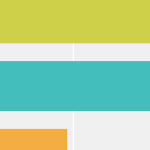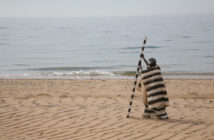Got an itch to scratch about a recent museum survey show? Want to flex your critical muscle about an under-recognized artist? Fancy researching and writing a long-form essay on the particulars of aesthetic theory? You’re in luck, because we editors are dying to read your writing.
If you’d like to write for the blog, please consider that we usually publish short-form reactions to and reviews of local art exhibitions, events or trends. (But local is such a plastic term, as is word-count.) Also, please bear in mind that while we want peer-reviewed material, we typically discourage friends from reviewing their friends' shows.
We schedule the blog about a month in advance and publish once a day, so if you have an idea or pitch for us, email Leah at triplett@bigredandshiny.com. She'll work with you to edit your post. She’s more than happy to help you hone your critical voice, so if you’ve never written for publication before, please don’t be shy. We want to hear from you! Which takes us to social media.
Over the past few years social media networks of all types have going through an evolution of sorts—first outright rejecting the possibility of paid content, then realizing that investors and shareholders expect them, as a business, to meet a bottom line financially and continue to grow. The way each network chooses to handle this is different: After being purchased by Yahoo, Tumblr now has intermittent "paid" posts by businesses but encourages those advertisements to use the aesthetic of the typical Tumblr post, sometimes resulting in creative GIFs that go unnoticed as being what they are. Instagram's recent acquisition by Facebook means that it will begin to slowly start rolling out advertising that the company says will focus on "beautiful, high-quality photos and videos from a handful of brands."1
Something that all of these brands typically note in their decision to switch to include advertising or paid options is their desire to grow, tackle new ideas, and create a more sustainable business to ensure they can serve their audience. These aren't uncommon desires... all things with which we at BR&S are familiar. Though we are not a for-profit venture, nor can we match the size of any of these massive organizations, sustainability and finances are constant worries. Since relaunching BR&S, nearly every non-profit arts organization in Boston that I've spoken to has said the same thing.
Facebook's solution to this problem has been, in part, their Edgerank algorithm. For the past few months Facebook has been "optimizing" the algorithms for nearly all aspects of their website and embedding new features merely noting that the changes are meant to further democratize your News Feed. Democracy implies voting, which FB interprets as how often you like, share, or interact with various users, pages, and businesses that use the platform. For example, if you love clicking on those Buzzfeed articles linked to by your obscure high school friend, you're likelier to see a status update about how much they hate shoveling their driveway rather than the great news that your best friend has to share.
This isn't the only factor in determining what you see, obviously. When you "like" a page or a business for the first time, you automatically "follow" them. It will show a check mark beside "follow". This means that, based on an obscure algorithm of how often you interact with this organization's posts, and how often the organization chooses to "boost" their posts, you will see some fraction of their posts in your News Feed. "Boosting" a post simply means that the business is paying a price (quite hefty usually) per post to make their posts to be seen by more people. This may be why you've noticed that you have been seeing few updates from us on your News Feed, as we, like many other small, local non-profits cannot afford to pay the premiums. To encourage users to begin "boosting" their posts, the FB algorithm penalizes posts from pages that contain photos or links, sometimes showing them to a mere 1% of followers. As a result, on our best days, many of our posts reach less than 16% of our followers on the platform.
Many of us agree, however, that despite recent changes and challenges, a social network presence and outreach strategy is necessary to business and community-building. So for the small number of you who are still able to view our Facebook posts, you may have noticed that they look different than usual--less visually appealing in our opinion. This is because we have taken recently to posting the link in the first comment rather than embedding it in the text of the post. It's a necessary evil because Facebook, at least for the time being, doesn't add that into their algorithm.
Big Red & Shiny has always been a labor of love. We work as part- and full-time volunteers at this organization because we believe it fills a void the in the Boston arts ecosystem. We welcome support of any kind that an individual or business wants to offer—whether financial, through contributing writing, in-kind donations, volunteering with us, or interacting with BRS on social media. In the meantime, here are some easy ways that you can continue to receive the content you want from us both on Facebook and elsewhere:
-
Visit our website and other websites like us directly.
Bookmark us in your browser. Save a link on your desktop. Any of these direct kinds of engagements are the easiest and most reliable ways to see all of the content we are providing and usually the most supportive to our business practices. We post regularly—5 times a week—and have 10 years of archived articles and interviews on the site.
-
Subscribe to our newsletter.
We only send it out once a week and it's a complete rundown of the articles posted in 7 days prior plus any snippets of news we are eager to share and should you ever tire of the updates it's easy to unsubscribe. We promise we won't send you any more emails than that and will never share your addresses or personal information with third parties.
-
"Like" our Facebook page, "like" our Facebook posts, and share our content!
As we explained above, the way you interact with your Facebook friends and pages to which you've subscribed heavily dictate what you'll see on your Facebook News Feed. Sharing and liking our content is the best way to signal to the FB algorithm that you want to continue to see our posts. Note: As we've taken to linking to our articles in the comment sections of our Facebook posts, 'sharing' an article has become much more difficult. If you see a post of ours that you'd like to spread around to your friends, press "share," then be sure to copy/paste the associated link into the body of the text!
-
Facebook interest lists.
If you want to see more updates from us and other pages that you like, you can also click the little gear icon at the top of our Facebook page on the far right and select "add to interest list." You can group many pages together on a theme to ensure that you never miss updates from the blogs and pages that you like.
-
Follow us on other social media platforms.
Other than Facebook we're on Twitter, Tumblr, Instagram, and (dare we mention it?) Google+. With the ever increasing restrictions being placed on organizations to reach their audience from Facebook, some analysts are saying that other platforms like Twitter and Google+ are going to shoot up in the number of daily users. Though we realize there's a lot of pushback and inherent problems within the Google+ platform it is still rather devoid of immediately visible commercialization. This allows us to continue to link to our articles in a dynamic and visually pleasing way and reach ALL of our followers. Though we're happy to go wherever is easiest for you!
[1] http://blog.instagram.com/post/63017560810/instagramasagrowingbusiness





